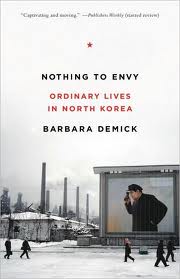
North Korea has always been an alluring topic to me. It’s the mystery, I suppose; that lingering curiosity of wanting to peek into a land frozen in time, barred from the outside world, especially for Americans to say the least. Demick’s book Nothing to Envy peels that mystery away and reveals what most already suspected — a society shackled to obdurate ideology, inculcated to deify a dictator as God, his son as a Christ-like figure.
I got to travel across the DMZ to the tourist town of Mount Kumgang in 2007, but, as Demick equally discovered, the North Korea put on exhibit to foreigners is a fraudulent, elaborate show, a far cry from the perpetual nightmare that its citizens believe to be the best option our world has to offer. Told through the personal stories of defectors in Seoul, Nothing to Envy uses a bit of a poetic license to describe places the author has never been, but does so with immaculate empathy and background knowledge of the culture and language. The defectors in Nothing to Envy invariably cross the Tumen River on the Chinese border, which at a certain time and/or price was extremely porous. From believing wholeheartedly in every paean to Kim Il-Sung she sang, a doctor Demick chronicles retells the shock she encountered when she reached a Chinese village across the border. Frozen and emaciated, she spotted a small farm house with a bowl of rice and a piece of meat in a bowl left in front of the door. It had been several years since she had seen rice, and now it was staring her in the face. The reality, as Demick describes through the doctor, was clear: ‘dogs in China ate better then doctors in North Korea.’
The following is an excerpt from Nothing to Envy:
Mi-ran and Jun-sang met when they were in their early teens. They lived on the outskirts of Chongjin, one of the industrial cities in the northeast of the peninsula, not far from the border with Russia.
The North Korean landscape is perfectly depicted by the black brushstrokes of Oriental painting. It is strikingly beautiful in places—from an American frame of reference, it could be said to resemble the Pacific Northwest— but somehow devoid of color. The palette has a limited run from the dark greens of the firs, junipers, and spruce to the milky gray of the granite peaks. The lush green patchwork of the rice paddies so characteristic of the Asian countryside can be seen only during a few months of the summer rainy season. The autumn brings a brief flash of foliage. The rest of the year everything is yellow and brown, the color leached away and faded.
The clutter that you see in South Korea is entirely absent. There is almost no signage, few motor vehicles. Private ownership of cars is largely illegal, not that anyone can afford them. You seldom even see tractors, only scraggly oxen dragging plows. The houses are simple, utilitarian, and monochromatic. There is little that predates the Korean War. Most of the housing stock was built in the 1960s and 1970s from cement block and limestone, doled out to people based on their job and rank. In the cities there are “pigeon coops,” one- room units in low- rise apartment buildings, while in the countryside, people typically live in single- story buildings called “harmonicas,” rows of one-room homes, stuck together like the little boxes that make up the chambers of a harmonica. Occasionally, door frames and window sashes are painted a startling turquoise, but mostly everything is whitewashed or gray.
In the futuristic dystopia imagined in 1984, George Orwell wrote of a world where the only color to be found was in the propaganda posters. Such is the case in North Korea. Images of Kim Il-sung are depicted in the vivid poster colors favored by the Socialist Realism style of painting. The Great Leader sits on a bench smiling benevolently at a group of brightly dressed children crowding around him. Rays of yellow and orange emanate from his face: He is the sun.
Red is reserved for the lettering of the ubiquitous propaganda signs. The Korean language uses a unique alphabet made up of circles and lines. The red letters leap out of the gray landscape with urgency. They march across the fields, preside over the granite cliffs of the mountains, punctuate the main roads like mileage markers, and dance on top of railroad stations and other public buildings.
LONG LIVE KIM IL-SUNG.
KIM JONG-IL, SUN OF THE 21ST CENTURY.
LET’S LIVE OUR OWN WAY.
WE WILL DO AS THE PARTY TELLS US.
WE HAVE NOTHING TO ENVY IN THE WORLD.